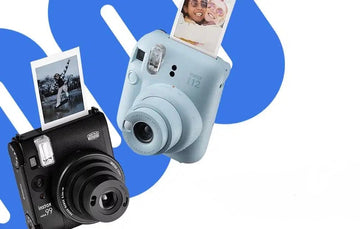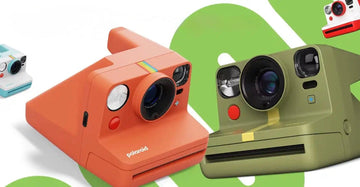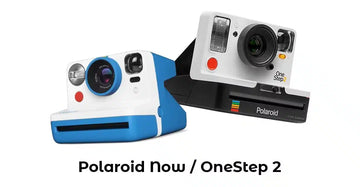Instax Mini: The History of a New Generation of Instant Photography
par Daria Tsurkan sur Aug 07, 2025

So similar, yet so different – the cameras from companies Polaroid and Fujifilm are today’s favorites in the instant photography market. They are often compared and confused, but in reality, they have little in common, except for one thing – instant photography.
History of Creation
The Japanese company Fujifilm is the creator and manufacturer of the Instax instant camera line, currently the most popular instant camera in the world. Fujifilm was founded in 1934 as Fuji Photo Film Co., Ltd, with the aim of producing photographic film. They quickly gained success among similar film manufacturers, which made the legendary company Kodak reconsider its standing. Over the years, Fujifilm expanded into various industries, including medicine, cosmetics, film, camera lenses, film cameras, and more recently, professional digital cameras.
Fujifilm's instant film products are based on the improved Polaroid SX-70 film, which the Eastman Kodak company sold to the Japanese in the 1980s after it was banned from producing its own instant film. Fujifilm had the opportunity to experiment with the acquired technology, which ultimately allowed the images to have incredibly clear results. After a series of successful experiments with the durability and color accuracy, in 1998, Fujifilm released the first Instax Mini camera line.

Compact, stylish, and easy to use – people loved taking small 8x5 cm photos, and this camera quickly gained popularity in the world of instant photography. The company had a promising future and a successful start to meet the needs of the market at the time. Today, Fujifilm offers a wide range of Instax Mini cameras: Mini 10, Mini 30, Mini 20, Mini 55, Mini 50/50s, Mini 7/7s, Mini 8, Mini 25, Mini 11, Mini 12, Mini 40, Mini 90, Mini Evo, Mini 99, Mini LiPlay, and the instax Mini Link photo printer.

Over time, the company began to look at things from a broader perspective. With the advent of Instax Wide film, Fujifilm introduced a new camera line with a wider field of view. However, the Mini camera line did not cease to exist, but instead continued to captivate the world with new features. Today, Instax Mini models are equipped with automatic exposure and focus systems, making it easy to obtain high-quality shots without complex settings.
Instax Mini from the Future

In 2021, Fujifilm shocked the world with its new camera, whose functionality knows no bounds. The digitalized capabilities of the Instax Mini Evo are simply amazing: the ability to duplicate previously taken photos from the camera's lens, Bluetooth connectivity to your phone, and the ability to control colors, filters, and the position of your photo on the film. Some say this camera destroyed the aesthetics of instant photography, while others interpret it as a new perspective on the world that humanity is relentlessly changing with artificial intelligence. Regardless, this camera truly deserves attention.
The Instax Mini Evo became the foundation for the creation of two generations of wireless Instax Mini Link printers that use Mini, Square, and Wide format films.

Instax Mini Film
The Instax Mini film format has won the hearts of millions of instant photography fans over the years. It is now hard to find anyone who has not heard of or seen the small rectangular frame with space for a caption at the bottom.

The first Instax Mini cartridges were white and had limited variety. Over time, the Mini format film gained a wide range of frame colors and even made numerous collaborations. Some of the most popular ones include: Instax and Disney Film, Instax + Mickey and Friends Film, Instax x Pokemon Go Film, Instax x Hello Kitty Film, Instax x Alice in Wonderland Film, and others.
The color palette of Instax cartridges is not as varied as, for example, Polaroid. Over 26 years of the line's existence, the company has introduced only color film and black-and-white monochrome.
Cameras Using Mini Cartridges
Polaroid MIO
Mini film is used not only in Instax Mini cameras. Three years after the release of the original Instax Mini 10, two giants made an unexpectedly strange yet historic collaboration: the joint Polaroid Mio camera. It was created for the American market and used Instax Mini cartridges (sold under the Polaroid Mio Film brand) with a design from Polaroid.

Polaroid 300
Later, the company that used the Polaroid brand after its bankruptcy announced the release of a new camera – the Polaroid 300, which turned out to be an Instax Mini 7S camera (under the Polaroid brand). It had nothing in common with previous cameras from the famous company. The film used by the Polaroid 300 had the same name as the camera, but it was simply the same Mini film under a different brand.

MINT InstantFlex TL70
In 2015, the American company MiNT surprised the world with a new camera, the vintage-style MiNT InstantFlex TL70. The camera has limited functionality compared to the Instax Mini Evo but does not fall short in the clarity of the photos it takes. This model will cost significantly more than any other Instax camera.


Lomography
The company Lomography released a whole line of Lomo’Instant cameras that use Instax Mini cartridges. These cameras differ greatly from Fujifilm cameras, both in terms of appearance and functionality. The Lomo cameras use higher-quality optics, which will appeal to professional photographers. These cameras also come with several accessories that help make your photos more creative.
However, these are not the only cameras that support the Mini film format. Over time, various cameras have been released by companies like Leica, SHARPER IMAGE, and Diana.




